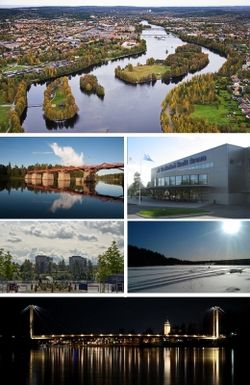Skellefteå
| Skellefteå | ||
|---|---|---|

Skellefteå in images
|
||
|
||
| Nickname(s): Schtaan, Guldstaden (Goldtown), Skellhell | ||
| Coordinates: 64°45′N 20°57′E / 64.750°N 20.950°ECoordinates: 64°45′N 20°57′E / 64.750°N 20.950°E | ||
| Country | Sweden | |
| Province | Västerbotten | |
| County | Västerbotten County | |
| Municipality | Skellefteå Municipality | |
| Area | ||
| • City | 21.74 km2 (8.39 sq mi) | |
| Population (31 December 2010) | ||
| • City | 32,775 | |
| • Density | 1,507/km2 (3,900/sq mi) | |
| • Urban | 72 025 | |
| Time zone | CET (UTC+1) | |
| • Summer (DST) | CEST (UTC+2) | |
| Area code(s) | +46 0910 | |
Skellefteå is a city and the seat of Skellefteå Municipality in Västerbotten County, Sweden, with 32,775 inhabitants in 2010. The municipality had approximately 72,000 inhabitants at the end of 2013. In the local accent the "å" is omitted and the city is pronounced locally as Skellefte.
The city is a historically industrial city with mining being a large industry, especially for gold – hence the nickname "Gold Town". Politically it is a Social Democratic stronghold. The city is a well-known ice hockey town, with its main team Skellefteå AIK playing in the Swedish top division, the SHL and being Swedish champions on multiple occasions.
The city was incorporated in 1845 and grew to its current population size mostly in the 1950s and 1960s, growing only slowly since. It is the second largest city in Västerbotten after Umeå and is located roughly halfway between it and Luleå. The river Skellefte älv passes through the city and it is located around 15 kilometres (9.3 mi) from the Bothnian Bay open sea. Skellefteå is served by Skellefteå Airport, locally known as Falmark, also around 15 kilometres (9.3 mi) from the city centre to the south.
The name Skellefteå is recorded to having been spelled as Skelepht in 1327. The origin of the name remains unknown.
From the 14th century on, attempts were made to Christianize Skellefteå. However, – for the most part – the entire large Northern Swedish territory of Norrland was not Christianized until several hundred years after the rest of Sweden, and many northern areas such as Skellefteå remained unexplored well past the Middle Ages.
Not before the very end of the 17th century did the indigenous Sami people of Northern Sweden begin turning into Christianity, much due to the efforts by the Northern Swedish superintendent Mathias Steuchius, who worked hard to accomplish this.
...
Wikipedia



